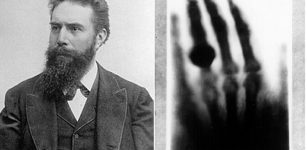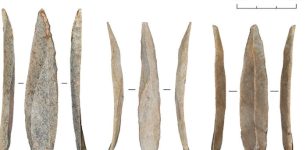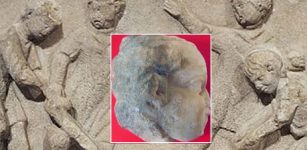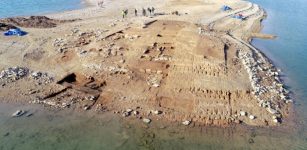Hundreds Of Fascinating 24,000-Year-Old Cave Paintings Discovered In Eastern Iberia
Conny Waters - AncientPages.com - It will take scientists a long time to examine all these ancient cave paintings and engravings. Archaeologists have discovered a major paleolithic cave art site, arguably the most important on Europe's Eastern Iberian Coast.
More than 100 ancient paintings and engravings, thought to be at least 24,000 years old, have been found in a 500-meter-long cave in "Cova Dones" or "Cueva Dones"—a site located in Millares near Valencia in Spain.
a) painted aurochs head; b) horse head made with clay; c) panel with several motifs painted with clay, including animals and signs (some partly covered by calcite layers) (figure by the authors Antiquity).
The cave site is well-known by locals and often visited by hikers and explorers, but the existence of paleolithic paintings was unnoticed until researchers from the universities of Zaragoza and Alicante (Spain), and affiliated to Archaeology at the University of Southampton (U.K.), made the exciting discovery in June 2021.
Findings of a study into the cave art, which highlight its true significance, are now published in the journal Antiquity.
Dr. Aitor Ruiz-Redondo, Senior Lecturer of Prehistory at the University of Zaragoza (Spain) and research affiliate at the University of Southampton (U.K.) comments, "When we saw the first painted auroch [extinct wild bull], we immediately acknowledged it was important. Although Spain is the country with largest number of Paleolithic cave art sites, most of them are concentrated in northern Spain. Eastern Iberia is an area where few of these sites have been documented so far.
Partly flooded chamber which contains most of the motifs. Credit: A Ruiz-Redondo/V Barciela/X Mart
"However, the actual 'shock' of realizing its significance came long after the first discovery. Once we began the proper systematic survey we realized we were facing a major cave art site, like the ones that can be found elsewhere in Cantabrian Spain, southern France or Andalusia, but that totally lack in this territory."
The research team of Dr. Ruiz-Redondo, Dr. Virginia Barciela-González, Senior Lecturer of Prehistory at the University of Alicante (Spain) and Dr. Ximo Martorell-Briz, research affiliate at the University of Alicante (Spain), have painstakingly documented more than one hundred motifs, or designs, at Cova Dones so far.
The large number of motifs and the variety of techniques involved in their creation make the cave the most important Paleolithic cave art site on the eastern Mediterranean coast of the Iberian Peninsula. In fact, it is probably the Paleolithic cave with the greatest number of motifs discovered in Europe since Atxurra (Bizkaia), in 2015.
The study highlights there are at least 19 confirmed animal representations, including hinds, horses, aurochs, and deer. Unusually, the majority of the paintings have been made using clay.
Two painted hinds heads. Credit: Ruiz-Redondo/Barciela/Martorell
Dr. Aitor Ruiz-Redondo explains, "Animals and signs were depicted simply by dragging the fingers and palms covered with clay on the walls. The humid environment of the cave did the rest: the 'paintings' dried quite slowly, preventing parts of the clay from falling down rapidly, while other parts were covered by calcite layers, which preserved them until today."
See also: More Archaeology News
Although painting in clay is known in Paleolithic Art, examples of its usage (or preservation) are scarce. In Cueva Dones, however, it is the main technique.
The researchers say their investigations are at an early stage and there are still many areas to survey and panels to document—so they are likely to reveal more art in the coming years.
The study was published in the journal Antiquity
Written by Conny Waters - AncientPages.com Staff Writer























